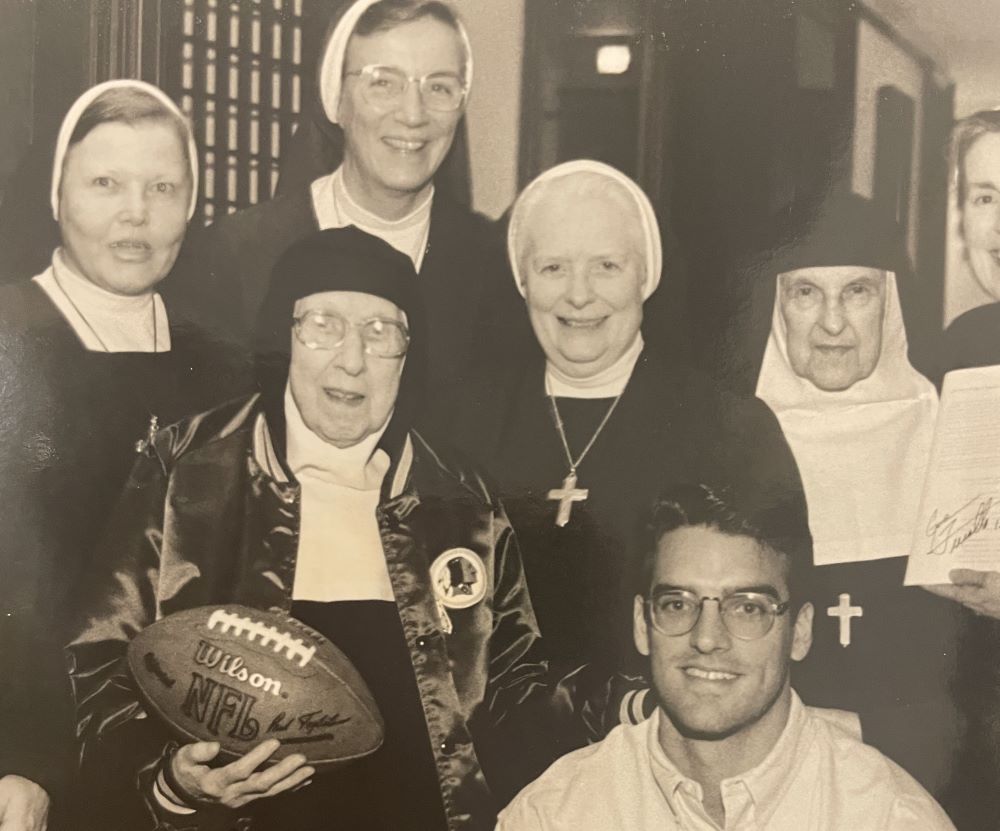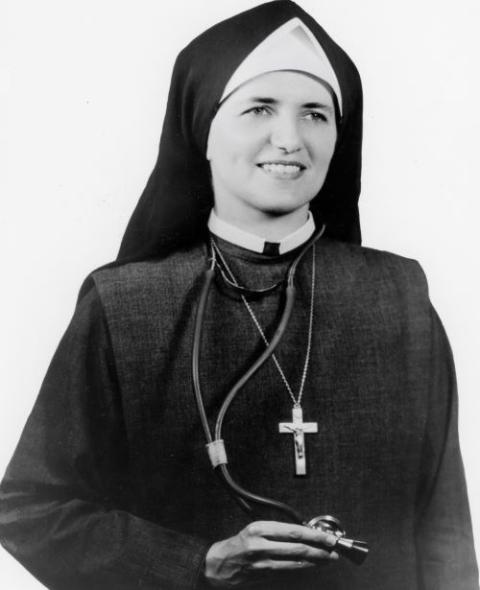
Visitation Sr. Marie Louise Kirkland holds the pigskin with Washington Redskins player Gus Frerotte on her 97th birthday in 1996. Others are (from left) Sr. Mada-anne Gell, Sr. Philomena Tisinger, Sr. Mary Berchmans Hannan and Sr. Anne Marie Di Menno. (Courtesy of Georgetown Visitation Monastery Archives, Washington, D.C.)
Editor's note: The author notes that this article was created, Wikipedia-style, with help from editor friends in the group Women in Religion. Thanks to (alphabetically) Anonymous, Colleen D. Hartung, Christine Meyer, Jere Odell and HWS.
Wikipedia is consistently one of the top-10-most-used websites in the world, yet, the lives of many prominent Catholic sisters are absent from its pages.[1] This is part of its urgent and complex gender problem, because by Wikipedia's own statistics, over 80% of its biographies are of men, and only 15% of its editors are women.[2] This disparity has a cascade effect, causing its gender bias to be replicated in other resources. To make my case for why Catholic sisters need more visibility on Wikipedia, I've designed this article like an actual Wikipedia page, complete with footnotes in its style.
I am a professional writer and editor, and so it may seem odd that I now spend time putting Catholic sisters' biographies on Wikipedia instead of, say, into standard Oxford University Press reference works, but I do it because of the impact. In 2021, editors at The Economist noted that Wikipedia is the single most-consulted reference work in history, with 20 billion pageviews per month.[3] Manhattan College history chair Jennifer C. Edwards writes that 75% of students refer to it.[4] American Historical Association past president William Cronon compared its reach to that of the Encyclopedia Britannica, but I say it goes much farther, into every life connected to the internet.[5]
Wikipedia certainly isn't the only reference work addressing a shortage of women's biographies, just the largest. For example, speaking of Oxford, in 2014 Oxford University Press invited me to review an effort to include more Catholic sisters in England's famous Dictionary of National Biography, the core reference work for notable lives in British history.[6] But the Dictionary of National Biography, and its American counterpart the American National Biography, are both primarily for scholars. I also wanted to see sisters' lives in places where everyone might find them. For better or for worse, that brings us back to Wikipedia.

Medical Mission Sr. Mary Frederic (Eileen) Niedfield, MMS, circa 1955, on her way to India as a surgeon, providing health care to women in rural areas. (Courtesy of Medical Mission Sisters, Unit North America)
To date I have published 43 original articles on Wikipedia, half of which are Catholic sisters, five are Catholic priests, and the rest interesting lay people. I was surprised that influential living sisters who are noted authors such as Franciscan Sr. Ilia Delio and St. Joseph Sr. Christine Schenk did not yet have pages, and it was a privilege to create those. I also love writing about sisters from history, such as the English Loreto Sr., Mother Mary Loyola, who was a bestselling author around the turn of the 20th century. My article on Daughter of Charity Regina Purtell, Army nurse to Teddy Roosevelt's Rough Riders during the Spanish-American War, received "good article" status and was linked on Wikipedia's front page, bringing her back to life for potentially millions of viewers. A piece on Medical Mission Sr. Eileen Niedfield, who attended Georgetown Medical School the first year they officially admitted women, graduating first in her class, is under review for "good article" status now.
For those who don't want to write whole articles from scratch, many entries need to be improved. For example, I provided substantial edits to the article about Georgetown Visitation Sr. Marie Louise Kirkland. "Weezie" was a regular on Washington, D.C., television in the 1980s, predicting football scores with Washington-area sportscaster Glenn Brenner and besting many professionals.[7]
One misconception about Wikipedia is that because it is an open-source platform where anyone can edit, then it must be riddled with errors. In fact, Wikipedia's reliability and verifiability currently rivals those of well-known encyclopedias, although there are still some exceptions.[8] A vast number of volunteer editors check new pages that fall under their expertise, and automated bots patrol for broken links, typos and more. Every detail must be footnoted using reliable, verifiable secondary sources including books, journal articles, websites, media and newspaper items. Policies on neutrality and conflict of interest also increase the reliability of the platform. Accepting money for editing usually results in immediate review and deletion of content, and my work for sisters will always remain volunteer.
I identify most Catholic sisters needing pages through Women in Red. This is a feminist effort overseen by some of Wikipedia's top editors that The Guardian called "heroic."[9] Rosie Stephenson-Goodnight, one of Women in Red's founders, told me via email that she has created many pages for sisters, including the Spanish writer and poet Gertrudis Anglesola and Canadian poet, dramatist and journalist Pauline Fréchette. Here is a link to Women in Red's "nuns" category (not all Catholic). You can check and see if your notable sisters are already on that list waiting for pages, and if not, I would be happy to guide you or your team to learn how to determine notability and add them.
Advertisement
This article is a call to action for any sister, or a friend of sisters such as archivists and digital media specialists, to reach out to me using this link. You can identify your congregation's key members from throughout its history who should be represented on Wikipedia, and then I will work with you either individually or as a group, typically via Zoom unless you are within a reasonable drive of Washington, D.C., or you want to bring me to you. Article creation is a detailed process with quite a few steps.
If you're new to this , I don't recommend you simply start editing Wikipedia on your own, because you can make frustrating and avoidable mistakes, get smacked by one of its bots or a grumpy volunteer editor, and then conclude it's all too difficult. It isn't. I promise. We can work on it together to ensure a great outcome.
[1] "Top Websites Ranking: Most Visited Websites in the World". Similarweb. Retrieved March 14, 2024.
[2] Graells-Garrido, Eduardo; Lalmas, Mounia; Menczer, Filippo (August 24, 2015). "First Women, Second Sex: Gender Bias in Wikipedia". Proceedings of the 26th ACM Conference on Hypertext & Social Media.
[3] The editors (January 9, 2021). "Wikipedia is 20, and its reputation has never been higher". The Economist.
[4] Edwards, Jennifer C. (May 2015). "Wiki Women: Bringing Women Into Wikipedia through Activism and Pedagogy". The History Teacher. 48 (3): 409–436.
[5] Cronon, William (February 1, 2012), "Scholarly Authority in a Wikified World | Perspectives on History | AHA". www.historians.org.
[6] Canzona, Joshua; Sargent, Carole; Leonard, Amy (May 10, 2014). Victoria Van Hyning (ed.), "Women religious in exile, 1550–1800, reviewed in the Oxford Dictionary of National Biography". History of Women Religious of Britain and Ireland.
[7] Hendrickson, Paul (November 14, 1989). "Sister Marie Louise Explains It All... How an 89-Year-Old Georgetown Nun Became the Number One Pigskin Prognosticator". The Washington Post.
[8] Cooke, Richard (February 17, 2020). "Wikipedia Is the Last Best Place on the Internet". Wired.
[9] Editorial Board (March 8, 2024). "The Guardian View on Wikipedia's Female Volunteers: a Hive Heroism that Changes History". The Guardian.







